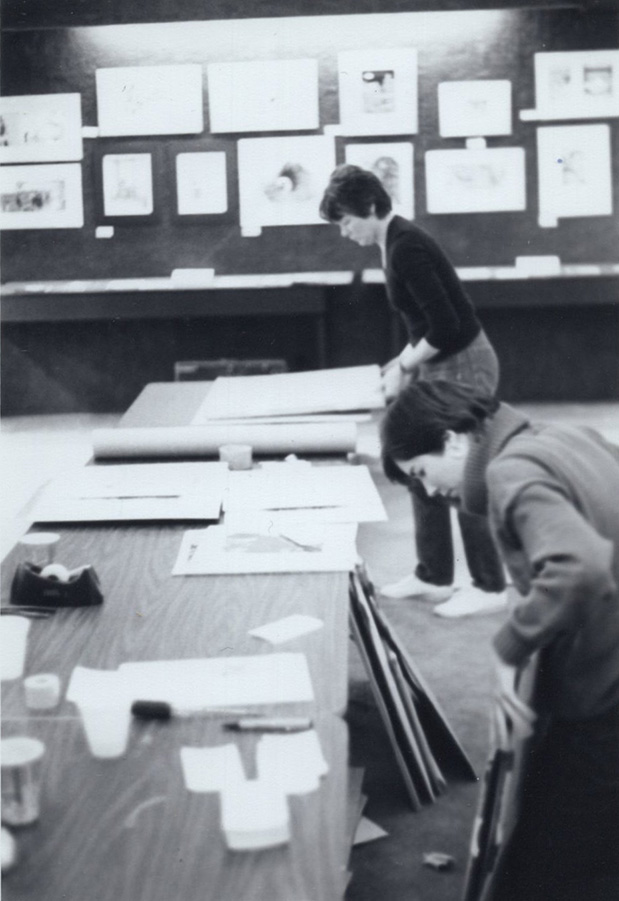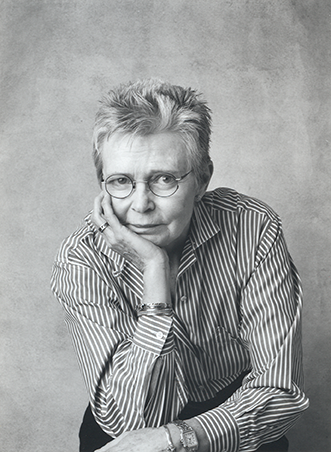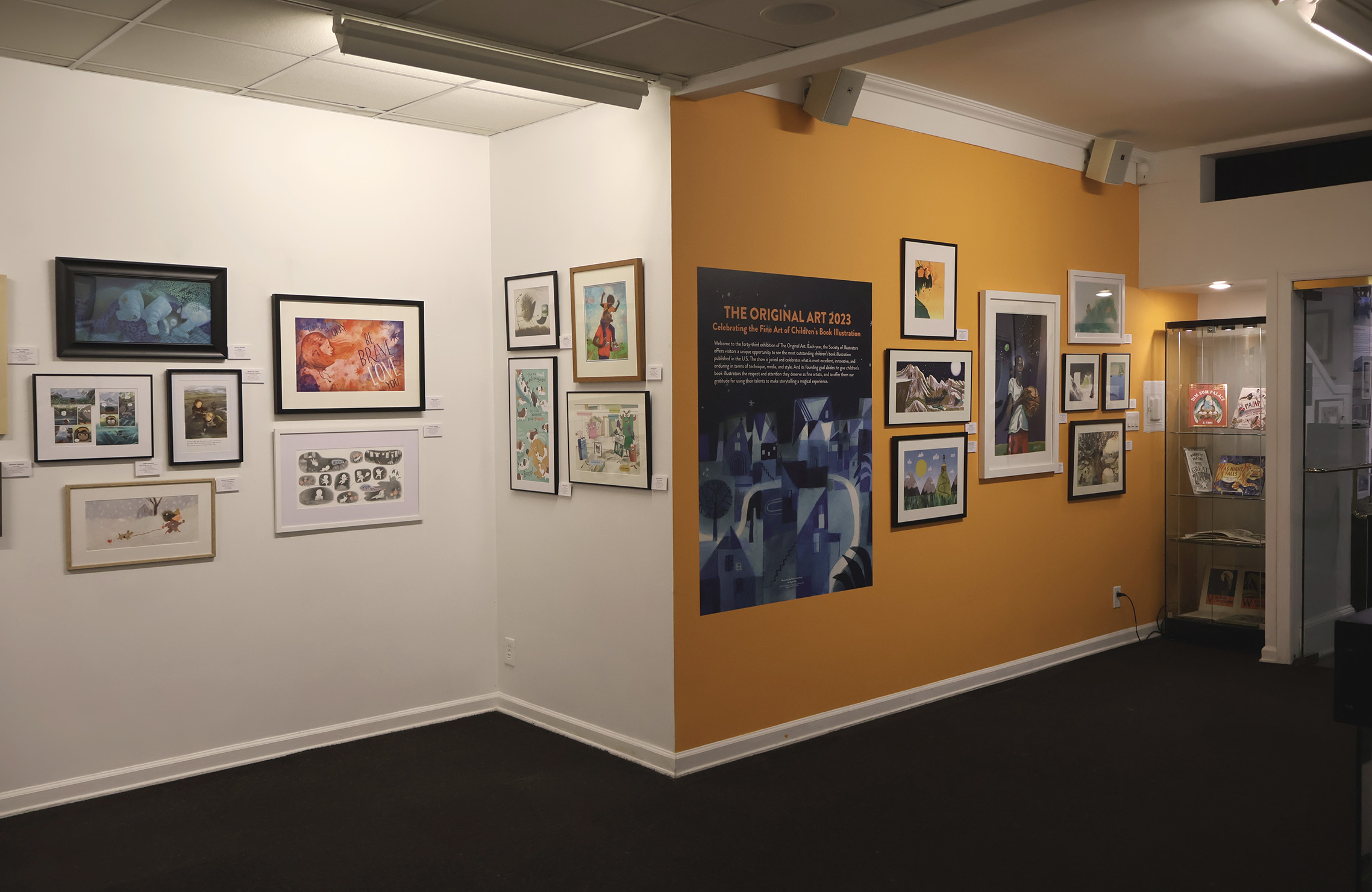It is with a very heavy heart that the Society of Illustrators announces the passing of longtime friend, founder of The Original Art exhibit, and pioneering children’s book illustrators’ agent, Dilys Evans.
Looking back . . . on an evening in October of 2007, I, a fresh-faced, recent college graduate with a new job and a lot to learn, sat on the floor of the lobby at the Society alongside Anelle Miller, my boss, the newly installed director. We had just experienced our first OA reception and awards ceremony, and we were stunned, exhausted, and completely inspired. Over two hundred beautifully crafted and framed pieces of art lined the Society’s walls, an exhibit which we had spent the prior week hanging, and for several hours that evening, five-hundred overjoyed children’s book illustrators, art directors, designers, publishers, agents, and fans had packed the galleries of the Museum to see the show. We were not prepared for that kind of crowd and probably made some embarrassing mistakes. But after that reception, we were determined to prove our worth to carry on the legacy of The Original Art.

Dilys Evans, with all her kindness and patience, guided us to success for years to come. She, alongside her co-founder Marcia Leonard and later advisor Laurent Linn, would teach the staff at the Society the importance of the art of children’s book illustration, how to look at and analyze a page from a book, and how to appreciate all of the details that go into a picture to further tell the story. Together, Marcia, Dilys, and Laurent provided step by step guidelines on how to organize the show—beginning with the initial call for entries, to organizing books for review, scheduling the judges, guiding the medal discussions, and hanging and framing the exhibit.
Dilys made it look effortless, but I recall her telling me about the many barriers she had to overcome to garner respect for the art of children’s book illustration, even within the Society of Illustrators’ own walls. Her vision for an exhibit to celebrate this underappreciated art form came to life in 1980. In its first iteration, the OA was displayed at the Master Eagle Gallery, a sixth-floor exhibit space offered by a group of printing and engraving companies located on twenty-fifth street in New York City. Dilys enrolled then publicist Marcia and artist and teacher Dick Morrill to help organize the show. She also recruited young illustrators to help frame and hang the art.
In her 2005 article written for The School Library, Marcia interviewed one of those young recruits, David Wiesner (winner of the 1992 Caldecott Medal for Tuesday and the 2002 Caldecott Medal for The Three Pigs, both published by Clarion). As he recalled, “It was a frantic rush to get it done in time. And overseeing it all was our fearless leader, Dilys. Fielding a never-ending stream of questions from dozens of people, she managed to stay outwardly calm and handle all the last-minute emergencies. Through sheer force of will, she brought ‘The Original Art’ into existence.”
The response to that first exhibit was tremendous. In addition to the enthusiastic praise from artists and the publishing industry, Mayor Ed Koch proclaimed the week of November 19 “Children’s Book Week” in New York City and urged people to attend the exhibit. And in a thousand-word review, the New York Times called the show “unusual and bountiful.”
In 1989, Master Eagle Gallery closed, and the OA needed a new home. Diane Dillon, the first female and first children’s book illustrator to serve as president of the Society of Illustrators, became the OA’s champion and introduced the show to the Board of the Museum.
It is here that I take a brief pause to recall another important lesson from Dilys. In those early days of my career at the Society, a lot was changing. For only the second time in the Society’s history, a female director with a new vision had been installed. At the same time, digital art was becoming a popular illustration technique, and many longtime illustrators became nervous about the change in direction both artistically and organizationally. Their reactions to the change were not to help the new staff, but to angrily abandon the Society during a time of transition. We received many messages of disapproval. As the receptionist at the time, I would field these angry phone calls and letters. But not all of the calls were critical. Sometimes I’d pick up the phone, and a cheerful, upbeat Dilys Evans would be on the other end, inquiring how we were handling the negativity. She became the Society’s confidence-builder. She would check in with us and tell us to be strong. She shared her stories of defending herself and her career and defending the art of children’s book illustration. She, too, received negative feedback about exhibiting the OA show at the Society. But she pushed ahead, convinced that the exhibit would elevate the Society by bringing new audiences into the building. And wow, was she right!


In the years since Dilys first introduced the show to SI, the OA has become the most popular exhibit of the year. Each October through December, endless school groups of all ages visit the Society. Some days, the galleries are filled with kindergarteners learning to read from the books on display. Other days, college students quietly study the linework and compositions of the pieces, seeking ways to influence their own techniques. Workshops, lectures, networking events, and story times are held amid the art. Our staff offers field trips for new visitors to the museum and teaches them about illustration and how children’s books are made. We even added a Holiday Craft Fair to coincide with the exhibit. And the OA continues to expand. Selections from the show have traveled to other museums and galleries throughout the country, and this year, the exhibit was a main feature at The Bologna Children’s Book Fair in Italy.
In 2008, Dilys passed on her knowledge of children’s book art to a wider audience with her book Show and Tell (Chronicle Books). In it, she analyzed twelve leading children’s book illustrators, describing their workand how they successfully portrayed the text. Interviewed by Marcia, Dilys introduced this book to the Society, and I am so thankful we captured this presentation with a video archive and can share it here in celebration of this outstanding woman.
On the night before Dilys’s passing, I sat in bed with my two children and read to them, while some visiting adult family members listened in. My choice was the 2022 OA silver medal winner The Night Wild by Zoë Tilley Poster (Penguin Random House / Dial Books for Young Readers). Without realizing what I was doing, I took my family through the pages of the book, describing the graphite illustrations and how the art was created using an eraser, explaining the lighting choices to show depth and change in atmosphere, and pointing out the sense of movement in the art. It took me about forty minutes to get through a thirty-two page book that had only a few sentences on each page, but everyone—young and adult—sat captivated. It was only later that I realized I was reading the book as Dilys had taught me to.
I’m so sad to lose Dilys. I am so thankful for her support and guidance, that she brought the OA to the Society and that she, Marcia, and Laurent helped it flourish here.
Dilys once wrote: “The definition of ‘art’ has been debated for centuries, but to my mind art happens when a particular creation stops us in our tracks. It makes us think. It touches our deepest emotions and oftentimes it teaches us something new.” I would say this definition perfectly describes Dilys as well.
Written by Kate Feirtag, July 24, 2024.
